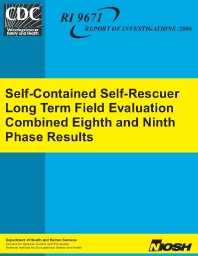Mining Publication: Self-Contained Self-Rescuer Long Term Field Evaluation: Combined Eighth and Ninth Phase Results
Original creation date: October 2006
The National Institute for Occupational Safety and Health (NIOSH) National Personal Protective Technology Laboratory (NPPTL) and the Mine Safety and Health Administration (MSHA) conduct a Long Term Field Evaluation (LTFE) program to evaluate deployed self-contained self-rescuers (SCSRs). The objective of the program is to evaluate how well SCSRs endure the underground coal mining environment with regard to both physical damage and aging when they are deployed in accordance with Federal regulations (30 CFR 75.1714). This report presents findings of the combined eighth and ninth phases of the LTFE. For these phases, over four hundred SCSRs were evaluated. The units tested include the CSE SR-100, Draeger Oxy K-Plus, MSA Life-saver 60, and the OCENCO EBA 6.5. The OCENCO M-20 was evaluated only in Phase 9. Testing was performed between December 2000 and April 2004. Results of the evaluation indicate that all SCSRs experience some performance degradation due to the mining environment. Observed degradation varies from elevated levels of carbon dioxide, high breathing resistance, and reduced capacity. Mechanical degradation to the SCSR components included breathing hoses, chemical beds, outer cases and seals. The LTFE tests discussed in this report are different from tests performed for SCSR certification to the requirements of 42 Code of Federal Regulations, Part 84 (42 CFR, Part 84). LTFE tests reported here are conducted to an end point, oxygen depletion, to enable comparison of the duration of new and deployed SCSRs. The method for obtaining deployed SCSRs for this evaluation was not a random selection from the deployed population of SCSRs. Although the results of these tests are useful for observing performance of the tested SCSRs, they are not representative of all deployed SCSRs. A new evaluation protocol, with revised sampling strategies, test methods, and reporting procedures, is currently being designed to enhance the generalizability of the results. This program will be implemented following completion of Phase 10 of the current LTFE protocol.
Authors: National Institute for Occupational Safety and Health
Report of Investigations - October 2006
NIOSHTIC2 Number: 20031089
U.S. Department of Health and Human Services, Public Health Service, Centers for Disease Control and Prevention, National Institute for Occupational Safety and Health, DHHS (NIOSH) Publication No. 2007-103, Report of Investigations 9671, 2006 Oct :1-51
See Also
- Experimental Mine and Laboratory Dust Explosion Research at NIOSH
- How to Operate a Refuge Chamber: A Quick Start Guide
- I Can't Get Enough Air! Proper Self-contained Self-rescuer Usage
- Measuring the Methane Content of Bituminous Coalbeds
- Performance Comparison of Rescue Breathing Apparatus
- Probability of Making a Successful Mine Escape While Wearing a Self-Contained Self-Rescuer
- Recommendations for Refuge Chamber Operations Training
- Refuge Chamber Expectations Training - 1.0
- Self-Contained Self-Rescuer Field Evaluation: Results From 1982-90
- Self-Contained Self-Rescuer Field Evaluation: Seventh-Phase Results
- Content source: National Institute for Occupational Safety and Health, Mining Program


 ShareCompartir
ShareCompartir
